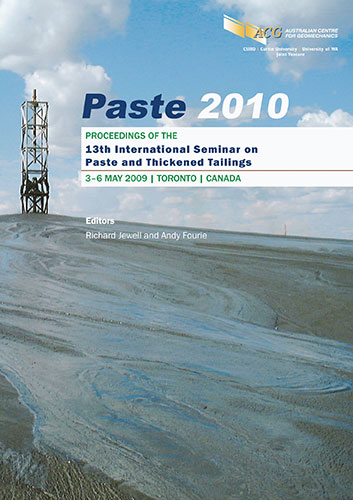Experimental study on unclassified tailings — water quenched slag paste-filled technology in Huize Mine

|
Authors: Wang, H-J; Wu, A-X; Jiao, H-Z; Zhou, B; Chen, J; Ji, X-W; Huang, J-R; Huang, X-G Paper is not available for download Contact Us |
DOI https://doi.org/10.36487/ACG_rep/1063_28_Wang
Cite As:
Wang, H-J, Wu, A-X, Jiao, H-Z, Zhou, B, Chen, J, Ji, X-W, Huang, J-R & Huang, X-G 2010, 'Experimental study on unclassified tailings — water quenched slag paste-filled technology in Huize Mine', in R Jewell & AB Fourie (eds), Paste 2010: Proceedings of the Thirteenth International Seminar on Paste and Thickened Tailings, Australian Centre for Geomechanics, Perth, pp. 319-328, https://doi.org/10.36487/ACG_rep/1063_28_Wang
Abstract:
Paste filling has been successfully used in Chihong Zinc and Germanium Mine (CZGM), which becomes the third mine to use this technology in China. Several current challenges faced by CZGM, such as lacking unclassified tailings, small particle size, limited surface for waste dumping, unusual nature of condensation, have prompted the choice of paste fill technology. A large number of laboratory experiments have been conducted to ensure the feasibility of paste filling in CZGM. Flow loop testing has been completed to investigate factors affecting the one way resistance with the result suggesting that the resistance along the way is 8 MPa/km. In practice, the true resistance is much smaller than this value. Simple process is the fundamental reason for the successful application of paste filling in CZGM. For unclassified tailing dewatering, a deep-cone thickener was used as one-part dehydration, and cement was added on ground without water. One-part pumping was selected instead of two-part horizontal hydraulic twin piston pump. The advanced distributed control system (DCS) was selected as well. The current problems faced by the filling system were analysed, and reasonable methods for addressing those problems have been put forward.
© Copyright 2025, Australian Centre for Geomechanics (ACG), The University of Western Australia. All rights reserved.
View copyright/legal information
Please direct any queries or error reports to repository-acg@uwa.edu.au
View copyright/legal information
Please direct any queries or error reports to repository-acg@uwa.edu.au